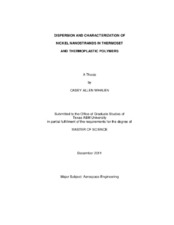| dc.description.abstract | Nickel Nanostrands (NiNS) are nano-particles that are highly branched and have a high aspect ratio. These particles show promise as excellent additives to composites when electrical conductivity is desired. Unfortunately, there is very little research done on dispersing powdered NiNS in various polymer matrices. This thesis covers the research in dispersing NiNS in three separate polymer systems, and related composite processing and characterization. An aromatic polyimide (CP2) is first used as a thermoplastic matrix and attempts to incorporate NiNS via an in-situ processing technique concurrent with in-situ polymerization are detailed. Epoxy is then used as a representative thermoset where the NiNS are dispersed in the resin before a hardener is added. The last polymer tested is thermoplastic Polyvinylidene Fluoride (PVDF). NiNS are introduced to this polymer in a solution mixture. Once dispersed, the PVDF solution is heated until the solvent evaporates leaving a PVDF melt containing NiNS, which is subsequently cooled. Samples of all three polymer nano-composites are created and dispersion is observed with an optical microscope. Using DSC, DMA and dielectric spectroscopy, thermal, mechanical and electrical properties are measured and analyzed.
Results for the CP2 nano-composites showed that during the cure phase, the NiNS settled to the bottom of the films resulting in a non-dispersed composite. This result highlighted the difference between NiNS and other more conventional nano-particles, namely that the NiNS are larger and heavier, therefore are not 'locked into' a dispersed state by the polymer chains. Several techniques were investigated for dispersing NiNS in the epoxy matrix. A method without solvent was shown to be the most effective and resulted in a well-dispersed nano-composite that showed increases in electrical conductivity and dielectric constant as NiNS concentration increases. Enhancement in storage modulus was observed above the composite's Tg as well. PVDF nano-composites also showed good dispersion and a general increase in electrical properties. Below Tg, storage modulus decreases at first before a slight recovery with increasing NiNS. Beyond Tg, the opposite effect is observed. FTIR measurements for the PVDF were also taken and showed no significant changes in the polymer morphology with additions of NINS. | en |


